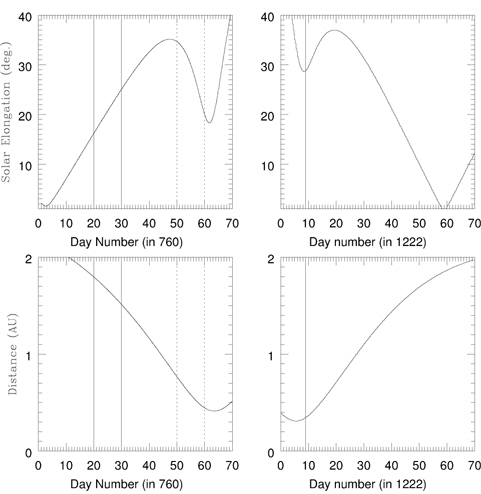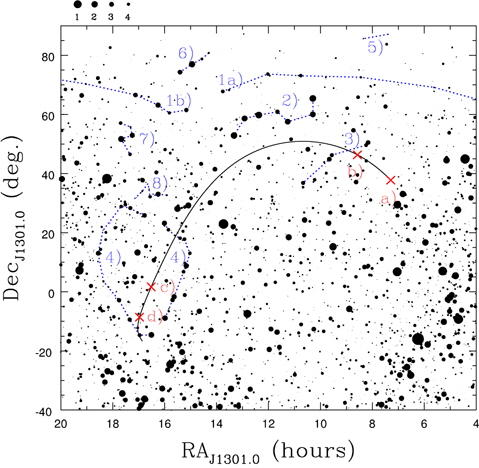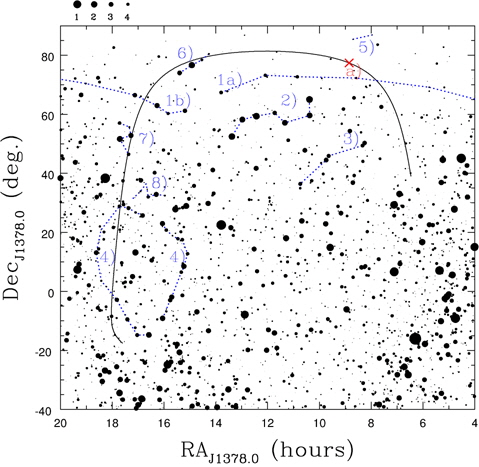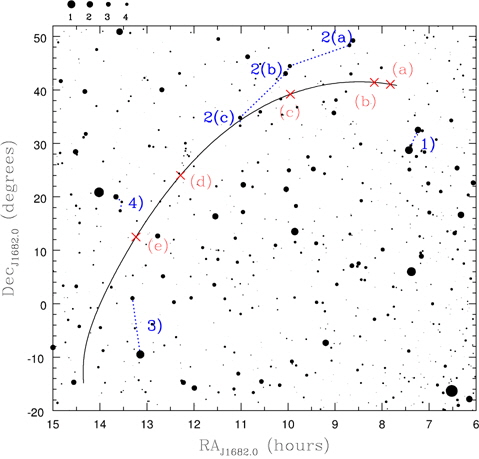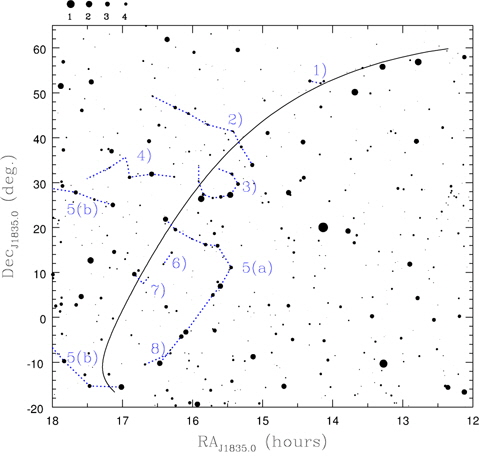



Halley computed orbital elements for 24 comets and predicted the reappearance of Halley’s comet in late 1758 or early 1759 based on a great similarity in Halley’s orbital paths of the comets that appeared in 1531, 1607, and 1682 (Halleio 1704, Yeomans 1991). Motivated by his work, many astronomers made efforts to observe the predicted comet beginning in 1755. Finally, a German amateur discovered the comet on December 25, 1759 using a telescope (Kronk 1999). Because of its periodicity and prominent appearance in the sky, this comet has been the subject of much attention and is one of the most studied historical comets (e.g., Ho 1962, Kiang 1972, Hasegawa 1979, 1980, 1984, Yeomans & Kiang 1981, Stephenson & Yau 1985, Sitarski & Ziolkowski 1988, Yeomans 1991). Nowadays this comet is formally called 1P/Halley (because it is the first known periodic comet) or Halley’s comet in honor of Halley’s pioneering work.
Because, as in other countries, the appearance of a comet was considered in Korea to be an evil omen of events that would happen in the near future, Korean astronomers also performed thorough observations and left extensive records. During the Joseon Dynasty, for example, a special observation team was organized, performed observations every night, and made daily Seongbyeoncheukhudanja (The Daily Reports of the Royal Astronomical Bureau on Special Astronomical Events; hereafter referred to as the Danja). In the case of the Danja, for the comet that appeared in 1664, while the original manuscripts are no longer extant, the position, moving direction, size, color, tail length, sketch (see Rufus 1936, Jeon 1974), observer’s name, and so forth are recorded. In the previous studies of Korean historical astronomical records, however, some records have been omitted or misunderstood. For this reason, we reexamined the Korean historical records on Halley’s comet covering the period from the Three Kingdoms (including the unified Silla Kingdom) to the Joseon Dynasty, i.e., 54 B.C. to 1910 A.D..
This paper is organized as follows. In section 2, we introduce the Korean historical documents and modern calculations used in this study. We analyze the accounts of Halley’s comet from the Three Kingdoms, the Goryeo Dynasty, and the Joseon Dynasty in sections 3, 4, and 5, respectively. Finally, we summarize our results in section 6.
2.1 Korean historical documents
Kronk (1999, 2003, 2007) compiled a series on ancient comets including Halley’s comet using not only various historical literature from all around the world but also the results of modern studies. In the books, he cites the dates when the comet was first discovered, passed perihelion, disappeared, and so on. Hence, we referred to his works in order to identify the account of Halley’s comet among the records presented in Korean historical materials. With regards to Korean historical documents, we mainly referred to the Samguksagi (The History of the Three Kingdoms) and Samgukyusa (The Legends and History of the Three Kingdoms), Goryeosa (The History of the Goryeo Dynasty) and Goryeosajeolyo (The Summary of Goryeosa), and Joseonwangjosillok (The Annals of the Joseon Dynasty; hereafter referred to as the Sillok) and Seungjeongwonligi (The Daily Reports of the Royal Secretariat; hereafter referred to as the Ilgi) for the periods of the Three Kingdoms, Goryeo Dynasty, and Joseon Dynasty, respectively. We also referred to the Jeungbomunheonbigo (The Revised and Enlarged Edition of the Comparative Review of Records and Documents on Korea; hereafter referred to as the Bigo) which covers the entire period considered in this study and hence was used as a main source in the studies of foreign scholars. However, the Bigo is very concise in its contents and is a secondary historical document, and even contains some mistakes (Lee et al. 2009).
One of the important steps in the study of historical astronomical phenomena is to correctly convert the dates of the luni-solar calendar used in the past into those of the modern calendar. In the conversion of a date, we employed the works of Ahn et al. (2000, 2009a, 2009b, 2009c), Han (2001a, 2001b), and Yang et al. (1999). If a Korean comet record appeared around the perihelion passage time of Halley’s comet given in the works of Kronk (1999, 2003, 2007), then we considered it an account of Halley’s comet.
Accurate positions of the periodic comets are obtained by numerical integration using the osculating orbital elements that are available for the instantaneous orbital at a given instant, so that this calculation of the position contains the effect of the perturbations due to other celestial bodies. In this paper, we used the algorithms of Meeus (1998), osculating orbital elements of Yeomans & Kiang (1981), astronomical ephemerides of Bretagnon & Francou (1988), and values of ΔT (i.e., the difference between terrestrial and universal times; for details, see Lee et al. 2011) from Morrison & Stephenson (2004) to compute the orbital path of Halley’s comet in each return. In addition, we also calculated the solar elongation and the distance from Earth for Halley’s comet appeared in 760 and 1222. Although Meeus’ (1998) algorithms are valid only for the osculating orbital elements, we assumed that those elements are invariant for a short period (at least three months), and this assumption does not have a significant effect on the results for the purpose of this study. With regards to the orbital path of Halley’s comet in each return against the stars’ positions at that time, we corrected the precessional effect using the values of Perryman et al. (1997). In addition, we referred to the works of Ahn et al. (1996) and Pan (2009) to identify oriental constellations (or enclosures) and stars. In this study, all dates are given in the Julian or Gregorian calendar unless otherwise mentioned.
According to Yeomans & Kiang (1981), Halley’s comet returned 13 times during the period of the Three Kingdoms (54 B.C. – 918 A.D.). Nonetheless, we could not find any account relevant to Halley’s comet from the Samguksagi. Moreover, neither comet was simultaneously observed in the Three Kingdoms (i.e., the Silla, Baekje, and Goguryeo kingdoms), as Rufus (1936) pointed out. Instead, there are only two cases where simultaneous observations occurred in two kingdoms: in the Silla and Baekje kingdoms in 191 and in the Silla and Goguryeo kingdoms in 668.
Meanwhile, Seo (2006) pointed out that the astronomical phenomenon mentioned in “Dosolga” (a folk song written during the Silla Kingdom) of the Samgukyusa is associated with the return of Halley’s comet in 760. Samgukyusa says that “two Suns appeared on the first day of the fourth lunar month in the nineteenth year of the reign of King Gyeongdeuk [i.e., April 20, 760 in the Julian calendar] and did not disappear for ten days.” He suggested the possibility that the character of Yun (i.e., leap) was omitted in the record of the Samgukyusa. According to Kronk (1999), Halley’s comet was first discovered in China on May 16 of the same year and passed the perihelion on May 20 (i.e., the first day of the fourth lunar leap month). He suggested that the reason that Halley’s comet was not observed during the daytime in China was because of the bad weather at Changan (the capital of the Tang Dynasty) at that time on the basis of the records of the Jiutangshu (The History of the Old Tang Dynasty). According to this historical book, heavy fog and rain occurred from the beginning of the fourth lunar month and cleared by the end of the fourth lunar leap month.
Considering the daytime appearance of a comet, Goryeosa says “a comet was seen near the Sun” on February 7, 1094 (which appearance is not listed in Kronk 1999), as Seo (2006) pointed out. We also found records indicating that “a comet was seen during the day” from the Samguksagi on May 28, 302 (this is also recorded in Chinese literature) and from Goryeosa on September 9, 1222. In particular, the latter is the record of Halley’s comet passing the perihelion on September 22 (see section 3.4). Marcus & Seargent (1986) suggested that Halley’s comet can be bright enough for a daylight observation due to an unusual forward scattering caused by dust when the comet is located between the Earth and the Sun. In Figure 1, we present the solar elongation (upper panels) and the distance from the Earth (lower panels) of Halley’s comet’s returns in 760 (left panels) and in 1222 (right panels). In the figure, the horizontal axes show the number of days counting from April 1, 760 (left panels) and from September 1, 1222 (right panels). That is, day number of 20 in the left panels represents on April 20, 760 (or April 1, 760 in the luni-solar calendar). As can be seen in the right panels, the solar elongation was ~30°, and the comet’s distance was ~0.36 AU on the date that the comet was seen during the day (i.e., September 9, 1222; see the solid vertical lines in the right panels). In the case of the year 760, however, it seems to us that the distance is too far to be seen during the day between April 20 and 30, i.e., ~1.7 AU (see the solid vertical lines in the left panels). If the date of the Samgukyusa’s record is the first day of the fourth lunar “leap” month (i.e., one month later), on the other hand, the probability of Seo’s (2006) suggestion becomes higher (see the dotted vertical lines in the left panels) under the assumption that the Korean record for the year 1222 is true.
In contrast with the Samguksagi, all apparitions of Halley’s comet during the period of the Goryeo Dynasty (918 - 1392) were recorded in the Goryeosa. During the Goryeo Dynasty, Halley’s comet passed the perihelion six times: in 989, 1066, 1145, 1222, 1301, and 1378. In the following subsections, we discuss the Korean records for each return.
According to Kiang (1972), Halley’s comet passed the perihelion on September 5.688, 989 in UT. Hence, he suggested that the Korean record of Goryeosa on October 18th, “a comet was seen” is too late for it to apply to Halley’s comet since Halley’s comet should not have been visible on that date. For this reason, he (also Stephenson & Yau 1985) concluded that this Korean account seems to not refer to Halley’s comet if the recorded date is correct. However, we think that it is worth paying attention to another of the Goryeosa’s records on the same day that describes how the king favored good politics such as self-reflection and the relief of tax arrears, so that (the appearance of ) the comet would not result in a disaster. This account could be interpreted to mean that a comet actually appeared earlier and that the disaster anticipated due to its appearance did not happen until October 18 because the king had governed well during the intervening period
As with the case of the year 989, Korean records only have one account (on April 20 and not April 19 as listed in Kronk 1999) of the return of Halley’s comet in 1066, which indicated that a star as big as the moon appeared in the northwest and suddenly transformed into a comet, but this is recorded in four historical documents including the Goryeosa. Nonetheless, this account has also been evaluated and judged to have a date that is likely incorrect. Kronk (1999) suggested that the account should be dated at around April 24 based on the location of the comet at that time.
3.3 Halley’s comet in 1145
In the case of Halley’s comet’s return in 1145, the Korean account on May 14, “a comet was seen in the northwest for 15 days, and its tail was approximately 10° long,” is recorded in the Goryeosa, Goryeosajeolyo, and Bigo. As Kronk (1999) indicated, this account implies that the comet was last detected on May 29. In this study, we found another record from a spirit-path sele of the great national master Tanyeon of the Dansok temple, which was built in 1172 but is no longer extant (Lee 1996). According to the spirit-path stele, the account that a comet was observed for around 20 days is described between the accounts on April 20 and May 29 of the twenty-fourth year of the reign of King Injong. It is known that the Goryeo court expressed the reign year such that the first year is the year that the king ascended to the throne, which is different from the convention used by the Goryeosa, which was compiled by the next dynasty. Hence, the twenty-fourth year of the reign of King Injong refers to the year 1145.
In contrast with previous cases, the apparition of Halley’s comet in 1222 was recorded to have occurred for five days. According to the Goryeosa, the comet was first observed on September 3, 1222 in the Sangtae constellation (the upper two stars in the Samtae constellation; see Figure 2), and its tail was 3° long and directed to the west. In addition, the comet became very bright on the 9th day, so that it could be seen in the daytime, presumably during twilight. In appendix A.1, we present an English translation of Korean accounts of the return of Halley’s comet in this year together with the references. With regards to the references, the abbreviations GS, GJ, DT, and BG represent the Goryeosa, Goryeosajeolyo, Dongguktonggam (The Complete Mirror of the Eastern Country), and Bigo, respectively.
The observation of this apparition of Halley’s comet is recorded to have occurred for four days, and the English translation of those accounts are presented in appendix A.2. With regards to the Korean account on October 1, Kronk (1999) pointed out that two locations were cited on one day, the Sangtae constellation (the upper two stars in the Samtae constellation, as mentioned before) and the Cheonsi Enclosure, and that these locations are separated by approximately 90°, hence this account seems to be in error. In Figure 2, we present the orbital path of Halley’s comet calculated using the orbital elements of Yeomans & Kiang (1981). In the figure, the (black) solid line is the orbital path of the comet, and the (red) cross symbols represent its positions on a) September 14, b) September 18, c) October 1, and d) October 9. For reference, we also depict oriental constellations: 1) the Jami Enclosure, 2) the Bukdu (Big Dipper) constellation, 3) the Samtae constellation (composed of the Sangtae, Jungtae, and Hatae constellations), 4) the Cheonsi Enclosure, 5) the Sabo constellation, 6) the Bukgeuk constellation, 7) the Cheonbang constellation, and 8) the Cheongi constellation. Park & Chae (2007) also depicted the orbital paths of the comet’s return not only in 1301 but also in 1222 and 1378 but using a different method: a multistep method which numerically integrates the motion of Halley’s comet backward in time (see also Park 2005). Based on both orbital paths, we suggest that the record on October 1 should be understood as the following: the comet located in the Sangtae constellation (on a previous day) had moved into the Cheonsi Enclosure on October 1 (refer to the next section for an explanation of the validity of this inference).
Although the Korean record has one account of Halley’s comet in 1378, its contents are more detailed than those of the years 989, 1066, and 1145. In the account of the Goryeosa on October 1, it was stated that a comet appeared in the Western Jami Enclosure, and trespassed the Sabo and Bukgeuk constellations. According to the orbital calculations using the elements of Yeomans & Kiang (1981), this comet researched a maximum declination of around +82° on October 2. Then the comet moved into the Eastern Jami Enclosure and approached the Cheonbang and Cheongi constellations. On the other hand, this comet was first discovered on September 26 in China and Japan. Figure 3 shows the orbital path of Halley’s comet in this year together with oriental constellations. In the figure, 1a) and 1b) represent the Western and Eastern Jami Enclosures, respectively, and a) is the comet’s position on October 1. As shown in Figure 3, we can infer that the Goryeosa’s records on Halley’s comet are, in general, the summary of several observations.
During the Joseon Dynasty, Halley’s comet passed the perihelion seven times: in 1456, 1531, 1607, 1682, 1759, 1835, and 1910. For the English translation of all Korean records on Halley’s comet observations during the Joseon Dynasty, except for those from 1456 and 1910, refer to Lee (2012). Because the records in the Ilgi are more detailed in description and extensive in number than those in the Sillok, the records of the former book for the years after 1623 are given in his work.
Considering the return of Halley’s comet in 1456, the first Korean account is the record on June 6 in the second year of the reign of King Sejo. After that, the comet was recorded for only ten days in the range from June 7 to 29. There are no records of the comet between June 13 and 19 because of its conjunction with the Sun, as pointed out by Kronk (1999). Moreover, all records simply indicated that a comet appeared, without further descriptions.
Contrary to Kronk’s (1999) description, the first observation by a Korean was actually August 4 (i.e., the 22nd day in the sixth lunar leap month of the twentysixth year of the reign of King Jungjong), which is one day earlier than that recorded by Chinese astronomers. This fact is found in the Sillok record on September 14, which refers to the report of Chu Im who was the governor of the Gyeongsang province. According to his report, a comet with a tail length of 3 - 4 Cheok (0.1 Jang = 1 Cheok = 10 Chon ~ 1° or 1.5°) was seen in the northern direction on August 4 and continued to appear for five days in that direction. From August 18, the comet moved into the western direction and was said to remain there until “the present”. However, “the present” does not mean the recorded day in the Sillok (i.e., September 14) but rather the day reported to the court because the Chinese record says that this comet stopped appearing on September 8.
As translated by Ho (1962), the Bigo records that “a comet appeared outside of the Eastern Taemi Enclosure on August 10. Its tail length was 15° long and the color was white.” Kiang (1972) judged this record to have appeared as early as 12 days before that, although the reason is unknown. According to the Sillok, however, the Bigo record is that of August 12 and not August 10. Furthermore, Kiang (1972) seems to have interpreted the reference to the Taemi Enclosure to refer to the Taemi constellation. The Enclosure covers a large area in the sky and contains several constellations including the Taemi, Samtae, and Nangwi constellations (see Figure 1 of Lee 2012). As can be seen in the figure, the Korean record seems to be reasonable considering the large territory of the Taemi Enclosure. Most significantly, the record on August 16 shows that Jupiter was placed at the same location as the moon, which proves the reliability of the Sillok records. According to our calculations, Jupiter was located within 0.85° from the moon just after sunset (i.e., 10.19 h in UT) on that day.
In the Seonjo volume of the Sillok, there are only six records of Halley’s comet reappearing in 1607, the fortieth year of the reign of King Seonjo. The first record was on September 23, and the last was around one month later, November 3. We also found another record from the revised Seonjo volume on August 22. According to the volume, “a comet that appeared between the bottom edge of the Samtae and the Bukgeuk constellations moved into the Nangwi constellation and then into the bottom edge of Cheon [probably Cheonsi] Enclosure. The comet did not disappear for a long time, and its tail length was about 10.5 – 12° long.” Based on the descriptions and the date, we inferred that the revised volume is a summary of the records of the Seonjo volume, but there is a mistake in the date.
Similar to the previous case, the Sillok only contains a few records on this periodic comet for a one-month period starting from August 24. On that day, the Sillok stated that a star like a comet was observed. It was seen above the Bukha constellation in the northeast direction (see Figure 4). On the other hand, the Ilgi has many records starting from August 25. Although the first record of the Sillok does not mention the observation time, according to the Ilgi, it was 5 Gyeong 3 Jeom (for the system by which the hour of the night was recorded in the Joseon Dynasty, refer to Lee et al. 2011). Therefore, we can be certain that no change in date was made in the Sillok for the observations during the night, as noted by several authors.
While the Ilgi records that the angular distance from the reference star (or ADR, for short) of the first lunar mansion was 7° on September 19, the Sillok recorded a value of 9°. Compared with the orbital path derived from the orbital elements of Yeomans & Kiang (1981), the latter value gives a smaller difference than the former one if the reference star of the first lunar mansion is
Both the Sillok and Ilgi contain detailed and numerous records that are different from the previous cases. In addition, the original source of both texts, Danja of the year 1759 for Halley’s comet, is preserved in the Yonsei University library (Nha 1982). The library also preserves Danja of other years, 1723 and 1760 (Nha et al. 2012). According to the Danja of 1759, the Korean astronomer officially discovered the comet on April 1, 1759 (the thirty-fifth year of the reign of King Yeongjo). Whenever there were unusual phenomena in the sky, the Joseon court organized a special observation team according to a traditional rule, performed observation every night in turns, and made daily reports (i.e., Danja) as mentioned above. Hence, Koreans may have first noticed the comet before April 1. However, the Sillok’s account begins on April 2, and it states that a comet was seen within the 11th lunar mansion, its size was similar to the star Hago, and the color was pale. The Ilgi’s account on the same date is more detailed than the Sillok’s – after the end of curfew (i.e., 5 Gyeong 3 Jeom), the star that had been seen within the 12th lunar mansion moved into the 11th lunar mansion. Its size was as big as the largest star in the Hago constellation (i.e.,
According to Korean records, Halley’s comet of 1759 was observed in the morning sky at least until April 17 and in the evening sky from April 27. Those descriptions show a good agreement with the orbital path of the comet. In addition, the records give a clue to what kind of astronomical instrument was used for observations in those days. That is, some records in the Ilgi mention a Gyugwan (a sighting tube), which was generally used in Honcheonwi (an armillary sphere) [N.B.: Gyuhyeong (a sighting measure) in a Soganui (a smaller, more simplified armillary sphere)]. We also know that Guk-Bin Ahn and Tae-Seo Kim were members of the observation teams from the record on May 5, which contains the conversation between them and the king.
For the appearance of Halley’s comet in 1835, the Sillok contains observational values for only two days: October 13 and November 19. On the other hand, the Ilgi has many and detailed records compared with the Sillok. Interestingly, both documents describe only the angular distance from the North Pole without referring to ADR. In Figure 5, we present the orbital path of Halley’s comet as it appeared in 1835 together with the following oriental constellations: the 1) Cheonchang, 2) Chilgong, 3) Gwansaek, 4) Cheongi, 6) Gok, 7) Du, and 8) Geosa constellations, respectively, and 5) the Cheonsi Enclosure.
The Sillok and Ilgi have no records for Halley’s comet when it passed the perihelion on April 20.18, 1910 in UT. This is probably because the Joseon Dynasty fell in August of that year. Most importantly, the Gwansangso (the new name of the Gwansanggam, the Royal Astronomical Bureau) was abolished in 1907. Therefore, it seems that there are no official records on Halley’s comet in 1910 in Korea.
We reexamined Korean historical records of Halley’s comet for the period from the Three Kingdoms to the Joseon Dynasty using historical documents such as the Samguksagi, Goryeosa, and Joseonwangjosillok. Strangely, we could not find any record corresponding to Halley’s comet for the Three Kingdoms era. With regards to Seo’s (2006) suggestion relating to Dosolga of the Samgukyusa, we think the likelihood that one of two Suns described in the song corresponds to the appearance of Halley’s comet in 760 is low if the date associated with observation is the first day of the fourth lunar month and not the fourth leap month. Meanwhile, we found that all appearances of Halley’s comet during the Goryeo Dynasty were recorded in history books of the dynasty although the dates of some accounts are questioned. In addition, we verified that the comet mentioned in the spiritpath stele of the great national master Tanyeon of the Dansok temple is the appearance of Halley’s comet in 1145. In the appendices, we transcribed the records of Halley’s comet from the historical literature of the dynasty for further studies. For the period of the Joseon Dynasty, we found that all returns of Halley’s comet were observed and recorded except for in 1910, when the dynasty had fallen. In particular, the contents of the Ilgi are the most detailed compared with other historical literature. In conclusion, we think that this study will be helpful for understanding the Korean historical astronomical records and for studying Halley’s comet.
